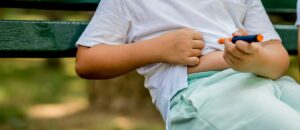There are 470,000 children in the United States living with epilepsy and with November being National Epilepsy Awareness Month, there is no better time to check in on your school’s seizure smarts. While school nurses are always ready to provide appropriate treatment and care in the event of a seizure, the onset of seizures is often extremely sudden and duration very short, which means school nurses are typically not present to provide the initial seizure first aid. Part of the school nurse’s responsibility in making school a safe environment is making sure school staff are able to recognize common seizures, take appropriate action to support and administer aid to a person suffering a seizure, and identify potential emergency situations that may require activation of EMS.
Types of Seizures
Seizures occur when there is a temporary change in the electrical signals of the brain, also thought to be a “short circuit” in communication between brain cells. Depending on the area of the brain affected, seizures can result in a change in a person’s movement, sensation, behavior, speech, or level of awareness.
- Tonic-clonic seizures are the type most people think of when they think of seizures. Signs of a tonic-clonic seizure include falling, jerking of limbs, body stiffening, a loss of consciousness, excess saliva, and a potential loss of continence. After a tonic-clonic seizure, it can be common to experience confusion, drowsiness, and/or agitation. These seizures typically last around 1-3 minutes but can be longer.
- Atonic seizures are usually much shorter in duration, often lasting under 15 seconds, and are distinguished by the sudden loss of or diminished muscle tone. Also called “drop” seizures, a person suffering an atonic seizure usually falls to the ground quickly with their head nodding or falling forward. While they may experience limpness and some slight confusion, full recovery is fairly quick following an atonic seizure.
- Myoclonic seizures can resemble tics or tremors, generally lasting just seconds and involving sudden jerking of muscles or limbs. Occasionally, a myoclonic seizure can result in falling, however, there is no loss of consciousness or awareness and recovery is rapid.
- Absence seizures involve the entire brain, are more common in children, and are non-convulsive. Signs someone is suffering an absence seizure include decreased responsiveness, a blank stare, fluttering eyelids, and eyes rolling back. This type of seizure begins and ends suddenly, with duration typically being under 10 seconds.
- Focal seizures can have different symptoms depending on the location of origin in the brain. Signs of a focal seizure can include confusion, visual disturbances, jerking of limbs, nausea, repetitive movements, heightened sense of fear, and difficulty speaking.
Seizure First Aid
For convulsive seizures (tonic-clonic) that involve a loss of consciousness, jerking, falling, and/or muscle stiffening:
- Always record the time and duration of the seizure
- Protect the head with something soft (if possible)
- Remove any objects that could cause injury
- Roll the person to their side (if possible)
- Do not restrain the person or put anything in their mouth
- Stay with the person, talking to them and assessing level of consciousness
For non-convulsive seizures that may involve sudden, unusual movements, confusion, or diminished awareness:
- Always record the time and duration of the seizure
- Do not restrain the person, but gently support, as necessary, to avoid injury
- Stay with the person, talking to them and providing reassurance
For any student with a history of seizures, in addition to the general first aid described above, an individualized seizure action plan should be on file and carefully followed, including administration of rescue medication, as prescribed and directed.
EMS activation should occur when:
- There is no known history of seizures or seizure action plan
- For any seizure lasting longer than five minutes
- For any loss of consciousness lasting longer than five minutes
- Injury is observed or suspected
- There is difficulty breathing following a seizure
- There are repeated seizures
- The seizure occurred in water or while eating or drinking
With epilepsy being the number one neurological condition among children in the United States, seizures at school are not uncommon. Educating school staff to be able to recognize potential symptoms of a seizure and provide appropriate first aid is imperative to cultivating a safe and supportive environment for students with epilepsy.





